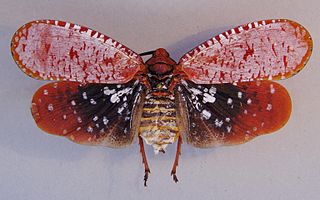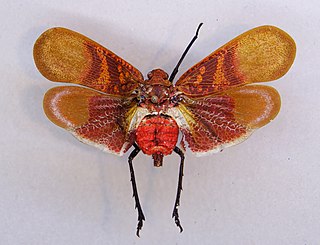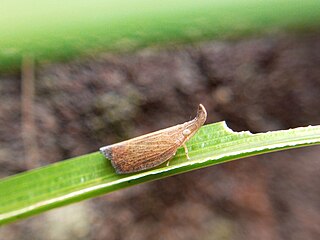
Ancyra is a small genus of planthoppers of the family Eurybrachidae and the only genus in the tribe Ancyrini. Species in this genus occur in southeast Asia.

The family Fulgoridae is a large group of hemipteran insects, especially abundant and diverse in the tropics, containing over 125 genera worldwide. They are mostly of moderate to large size, many with a superficial resemblance to Lepidoptera due to their brilliant and varied coloration. Various genera and species are sometimes referred to as lanternflies or lanthorn flies.

Delphacidae is a family of planthoppers containing about 2000 species, distributed worldwide. Delphacids are separated from other "hoppers" by the prominent spur on the tibia of the hindleg.

The subfamily Aphaeninae is a group of hemipteran insects, especially abundant and diverse in the tropics, in the family Fulgoridae, or "lanternflies".

Issidae is a family of planthoppers described by Spinola in 1839, belonging to the order Hemiptera, suborder Auchenorrhyncha superfamily Fulgoroidea.

Nogodinidae is a family of planthoppers. They have membranous wings with delicate venation and can be confused with members of other Fulgoroid families such as the Issidae and Tropiduchidae. Some authors treat it as a subfamily of the Issidae.

Penthicodes is a genus of planthoppers belonging to the family Fulgoridae, subfamily Aphaeninae: found in South-East Asia. The genus name was formerly treated as feminine, but in 2022 it was revised to masculine in accordance with ICZN Article 30.1.4.4, changing the spelling of several species' names.

Gergithus is a genus of tropical Asian planthoppers in the family Issidae, erected by Carl Stål in 1870. Like all planthoppers, adults feed on plant sap and are capable of escaping by leaping. The genus like other members in the tribe appears somewhat rounded and beetle-like, in some cases, with a mimetic resemblance to ladybird beetles. Species are mostly distributed in the Indomalayan Realm.

The subfamily Poiocerinae include Hemipteran insects in the family Fulgoridae, found especially in the tropics.
Aphrodisias is a Central American genus of planthoppers in the family Fulgoridae and tribe Fulgorini.

Scamandra is a genus of planthoppers in the subfamily Aphaeninae (Fulgoridae): found in Malesia.

Pyrilla is a genus of bugs in the subfamily Lophopinae and tribe Lophopini.
The Gengidae are a family of Fulgoromorpha (planthoppers), with species found in South Africa.

Hemisphaerius is a genus of bugs in the family Issidae and tribe Hemisphaeriini. Species resemble the closely related Gergithus: but are differentiated in this genus by the size of the frons and shorter legs.

The Hemisphaeriinae are a subfamily of bugs in the family Issidae, based on the type genus Hemisphaerius. Species in 119 genera have been recorded in most continents, but the greatest diversity appears to be in South-East Asia.

Eurybrachys is a genus of bugs in the family Eurybrachidae. First formally named in 1834 by French entomologist Félix Édouard Guérin-Méneville, Eurybrachys is the type genus of the family Eurybrachidae. The spelling Eurybrachis, by the author, is considered an unaccepted orthographic variant. Species in this genus occur in Asia.

The Menoscinae are a subfamily of planthoppers in the family Lophopidae erected by Leopold Melichar in 1915. Most genera are recorded from SE Asia through to Australia, but the single genus in tribe Carrioniini is Neotropical.

Zophiuma is a genus of planthoppers in the tribe Acarnini, erected by Ronald Gordon Fennah in 1955. Distribution records are limited to the New Guinea region.
Platybrachys is a genus of Australian Fulgoromorph planthoppers within the family Eurybrachidae.

The Amyclinae are a subfamily of planthoppers in the Auchenorrhyncha, whose Basionym was first used by Zeno Payne Metcalf in 1938. The recorded distribution is the Americas, Africa, Malesia and Australia.

















